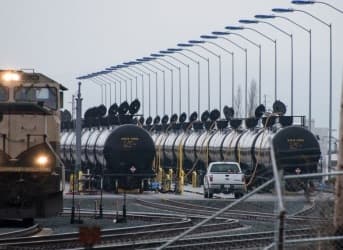Most historians date the Railway Age as beginning in 1830, when the Liverpool and Manchester Railway opened, providing the first steam passenger service, proving the viability of rail transport.
Its fuel – wood.
As the 19th century wore on, wood was replaced as the fuel of choice by coal, which had a higher caloric content. In the 20th century, coal in turn was superseded by both diesel and electricity.
The need for increased horsepower and boiler pressure saw a swift shift to coal as the fuel of choice, a sufficiently efficient choice that China only recently stopped building coal-fired locomotives.
Since the Second World War the diesel-burning locomotive became the choice of American railways.
Now, a number of locomotives will soon begin burning natural gas in a potentially historic shift.
Related article: DOT-111 Safety Major Issue in Crude-By-Rail Debate
Why would railways turn away from a fuel source that has served them so well in the past? Reduced fuel costs, a technology that would cut pollution emissions and, best of all, strengthen the advantage railways hold over trucks in long-haul shipping, which have been hammered since the 1950s with the development of the U.S. road network.
While electric-powered locomotives were the vehicle of choice for U.S. railways, like the coal-fired railways, they have been beholden to the critical bottleneck to transmitting the required voltage over many hundreds of miles along railway lines, which frequently run through isolated population areas, requiring booster stations to retain required voltages. Independent locomotives fueled by natural gas would end the need to be connected to the national electrical grid for power.
Rail companies want to take advantage of booming natural gas production that has cut the price of the fuel by as much as 50 per cent. So they are preparing to experiment with redesigned engines capable of burning both diesel and liquefied natural gas
The future?
BNSF Railway Co., one of the biggest U.S. consumers of diesel fuel, plans this year to test using natural gas to power its locomotives instead.
BNSF Chief Executive Matt Rose said "This could be a transformational event for our railroad," adding that the railway’s transition to natural gas as locomotive fuel would "rank right up there" with the industry's historic transition away from 19th century’s shift from coal-fired steam engines last century.
Related article: EU Readies for Shale Gas Breakthrough
…and Warren Buffet, America’s second-richest man, not renowned for making rash fiscal decisions, own BNSF Railway Co. America’s largest railroad, BNSF estimates it is the second-biggest user of diesel in the country, after the U.S. Navy.
ADVERTISEMENT
But such change would come slowly, as a full-scale shift to natural gas would require expensive new infrastructure across the nation’s 140,000-mile freight-rail system. Quite aside from retooling the U.S. locomotive fleet, such a retrofitting transition would require developing dozens of fueling stations as well as retooling existing locomotives. Railroads are interested because new engines burning a mixture of diesel and natural gas would be the quickest and easiest way to adopt the new technology, estimated to cost less than a new locomotive at roughly $2 million.
At the end, it will all come down to the bottom line of dollars and cents. But the reality is that natural gas production in the U.S. is surging, which will mean an increasingly decreased fuel cost as U.S. natural gas production intensifies. On the plus side, locomotive makers say that natural gas engines would also significantly reduce emissions compared with diesel locomotive, scoring U.S. railways points as a cost effective way to reduce greenhouse gas emissions.
While the future of NATGAS railway locomotives is still in its early stages, the fact that America’s “sage of Omaha,” America’s second richest man, is betting on the technology should focus attention on the U.S. railway shift from heavy hydrocarbon fuels to cleaner natgas to consider the future of U.S. railways.
By. John C.K. Daly of Oilprice.com


















